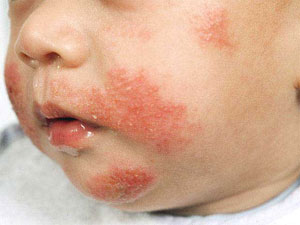WHAT IS ECZEMA?
The term 'eczema' is used in two different ways. It can be
used widely to describe any rash-like skin conditions. It is usually used
specifically to refer to the most common type of these skin conditions: atopic
dermatitis.
- § Allergic
contact eczema (dermatitis) - a reaction where the skin has come into contact
with a substance that the immune system recognizes as foreign
- § Contact
eczema - a localized reaction where the skin has come into contact with an
allergen
- § Dyshidriotic
eczema - irritation of skin on palms of hands and soles of feet, characterized
by blisters
- § Neurodermatitis
- scaly patches of skin on head, forearms, wrists, lower legs caused by
localized itch such as an insect bite
- § Nummular
eczema - circular patches of irritated skin that can be crusted, scaling and
itchy
- § Seborrheic
eczema - oily, scaly yellowish patches of skin, usually on scalp and face
- § Stasis dermatitis - skin irritation on lower
legs, usually related to circulatory problems.
Signs and symptoms
of eczema

- § Rashes
commonly appear on scalp and cheeks
- § Rashes
can bubble up before weeping fluid
- § Rashes
can cause extreme itchiness, which may lead to trouble sleeping. Continuous
rubbing and scratching can lead to skin infections.
- § Rashes
commonly appear behind the creases of elbows or knees
- § Also
common on neck, wrists, ankles, crease between buttock and legs.
- Over time, the following symptoms can manifest:
- § Rashes
can become bumpy, like goosebumps
- § Rashes
can lighten or darken in color
- § Rashes
can thicken (also known as lichenification) and then develop knots and a
permanent itch.
- § Rashes
commonly appear in creases of elbows or knees or nape of neck
- § Rashes
cover much of the body
- § Rashes
can be especially prominent on neck, face and around the eyes
- § Rashes
can cause very dry skin
- § Rashes
can be permanently itchy
- § Rashes
can cause scaly skin (more scaly than in children)
- § Rashes
can lead to skin infections.
Skin features associated with atopic
dermatitis:2
- § Atopic
pleat - an extra fold of skin that develops under the eye
- § Cheilitis
- inflammation of the skin on and around the lips
- § Hyperlinear
palms - increased number of skin creases on the palms
- § Hyperpigmented
eyelids - eyelids that have become darker in color from inflammation or hay
fever
- § Ichthyosis
- dry, rectangular scales on the skin
- § Keratosis
pilaris - small, rough bumps, generally on the face, upper arms and thighs
- § Lichenification
- thick, leathery skin resulting from constant scratching and rubbing
- § Papules
- small raised bumps that may open when scratched and become crusty and infected
- § Urticaria
- hives (red, raised bumps) that may occur after
exposure to an allergen, at the beginning of flares, or after exercise or a hot
bath.

Signs and symptoms of eczema

No comments:
Post a Comment